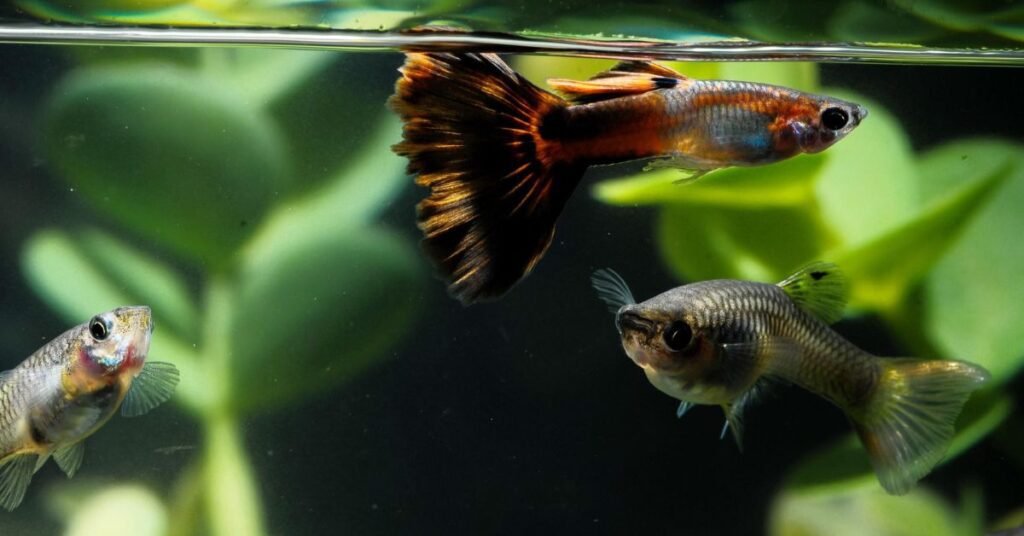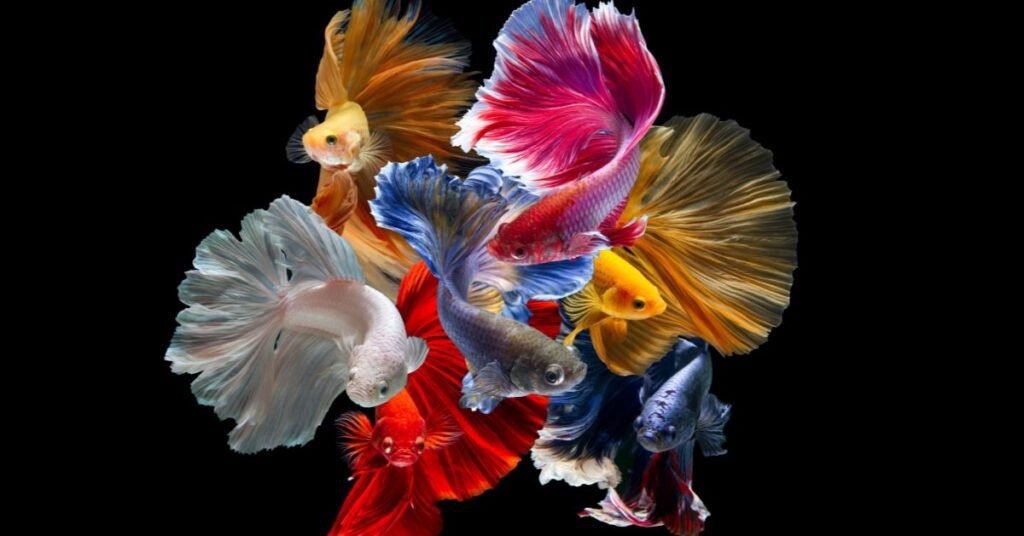Introduction
Betta fish are very popular pets. They are colorful and have big fins. Many people like them because they are easy to care for. But, you need to set up their tank carefully to keep them healthy and happy. This article will help you set up a tank for your betta fish. We will show you what equipment you need and how to keep the water clean and healthy.

Betta Fish Tank Requirements
Before setting up a betta fish tank, it’s essential to understand the basic requirements of these fish. Betta fish are tropical fish that thrive in warm water (76-82°F) with a pH range of 6.5-7.5. They require a minimum tank size of 5 gallons, with a secure lid to prevent jumping. Betta fish are solitary creatures and should be kept alone, as they can be aggressive towards other fish.
Choosing the Right Betta Fish Tank Size
When it comes to choosing the right tank size for your betta fish, bigger is better. A minimum tank size of 5 gallons is recommended, but larger tanks (10-20 gallons) provide a more stable environment and plenty of space for your betta to swim. Avoid small tanks (less than 5 gallons) and bowls, as they can lead to water quality issues and stress on your betta.
Betta Fish Tank Equipment and Accessories
To set up your betta fish tank, you’ll need the following equipment and accessories:
Heater: Betta fish require warm water, and a heater will help maintain a consistent temperature. Choose a heater that can heat the water to 76-82°F.
Filter: A good filter will help keep the water clean and clear. Choose a filter that is designed for small tanks (less than 10 gallons).
Lighting: Betta fish require low to moderate lighting. Choose LED or T5 lighting, and avoid direct sunlight.
Gravel and Decorations: Gravel and decorations will help create a comfortable environment for your betta. Choose gravel that is specifically designed for aquariums, and add decorations such as plants, rocks, and driftwood.

How to Set Up a Betta Fish Tank
Step 1: Choose the Right Tank
Get a tank that is at least 5 gallons big. Betta fish need space to swim! Make sure the tank is made of glass or acrylic. Avoid metal tanks! Pick a tank with a secure lid. Betta fish can jump.
Step 2: Add Gravel and Decorations
Gravel helps keep the water clean. Choose gravel made for aquariums! Add decorations like plants, rocks, and driftwood. Betta fish love hiding places! Rinse gravel and decorations in water before adding them to the tank.
Step 3: Install the Heater and Filter
Betta fish need warm water (76-82°F). Get a heater that can do that! A filter keeps the water clean. Choose a filter for small tanks (less than 10 gallons)! Follow the instructions to install the heater and filter.
Step 4: Add Lighting
Betta fish need low to moderate lighting. Choose LED or T5 lighting! Avoid direct sunlight. It can harm your betta fish! Add lighting to the tank, but not too bright.
Step 5: Add Water
To remove chlorine and chloramines from the tap water, use a water conditioner. Fill the tank with water, leaving about an inch at the top. Make sure the water is at the right temperature (76-82°F).
Step 6: Cycle the Tank
Add beneficial bacteria to the tank. You can get them at pet store. Monitor water parameters (ammonia, nitrite, nitrate) with a test kit! Perform water changes (25-50% every 1-2 weeks) to keep the water clean.
Step 7: Add Your Betta Fish
Once the tank is cycled, you can add your betta fish. Float the unopened bag in the tank for 15-20 minutes to acclimate your betta. Place your betta fish into the tank it will live in.
Step 8: Maintain the Tank
Feed your betta fish 2-3 times a day as much as they can take within 1-2 minutes. Remove any visible debris or waste daily! Perform regular water changes and monitor water parameters.

Best Betta Fish Diet and Nutrition
Betta fish need a balanced diet to stay healthy and strong. The best foods for betta fish are high in protein and low in fiber.
Betta pellets are a great main staple food, but it’s important to mix it up and give your betta a variety of foods.
Frozen bloodworms and live blackworms are yummy treats that are packed with protein. Freeze-dried foods like brine shrimp and krill are also great options.
Insect-based pellets can provide extra protein and vitamins. Daphnia can help if your betta is constipated. It’s important to not overfeed your betta, as this can lead to health problems.
Aim for 2-3 meals a day, only as much as they can eat in 1-2 minutes. By feeding your betta a variety of nutrient-rich foods, you can keep them happy and healthy.
Betta Fish Tank Water Parameters and Quality
Maintaining good water quality is important for the health and happiness of your betta fish. Monitor the following water parameters:
- Ammonia: 0 ppm
- Nitrite: 0 ppm
- Nitrate: <20 ppm
- pH: 6.5-7.5
- Temperature: 76-82°F
Betta Fish Tank Maintenance Schedule and Tips
To keep your betta fish healthy and happy, you need to take care of their tank. Check the water temperature and pH every day.
Feed your betta fish 2-3 times a day, but only as much as they can eat in 1-2 minutes. Remove any visible debris or waste daily.
Change 25-50% of the water every 1-2 weeks. Clean the gravel and decorations monthly. Check the filter and replace it as needed.
Test the water parameters monthly. Keep the tank away from direct sunlight. Don’t overcrowd the tank with too many decorations.
Don’t tap on the glass or disturb your betta fish. Keep the tank lid secure to prevent jumping. Monitor your betta fish for signs of illness. Keep a record of water changes and maintenance

Common Mistakes to Avoid When Setting Up a Betta Fish Tank
When setting up a betta fish tank, it’s important to avoid some common mistakes that can harm your fish or lead to an unhealthy environment.
First, don’t use a tank that’s too small (less than 5 gallons). Betta fish need space to swim and thrive, and a small tank can lead to stunted growth and stress.
Avoid using a tank with a metal frame, as it can rust and leak toxic chemicals into the water, harming your fish.
Don’t forget to add a heater, as betta fish need warm water (76-82°F) to stay healthy. A heater will help maintain a consistent temperature, even in cold rooms.
Don’t overcrowd the tank with too many decorations or other fish. Betta fish are solitary creatures and prefer to have their own space.
Too many decorations can also create hiding places for bacteria and debris, leading to poor water quality.
Avoid using gravel that’s too rough or has sharp edges, as it can harm your fish’s fins and scales.
Don’t forget to cycle the tank before adding your betta fish. Cycling the tank allows beneficial bacteria to establish themselves, which helps break down waste and keep the water clean.
Avoid adding your betta fish to the tank too soon, as it can be stressful for them. Finally, don’t forget to add a secure lid, as betta fish can jump and may try to escape if the lid is not secure.
Conclusion
Betta fish are amazing pets that bring joy and beauty to our lives. To keep them happy and healthy, we need to provide proper care.
This includes setting up a betta fish tank a big enough tank with warm water, a heater, a filter, and a lid. We must also feed them a variety of foods and change some of the water every week.
Monitoring water temperature and pH is crucial to prevent illness. Keeping their tank clean and tidy can prevent germs from growing.
With proper care, betta fish can live a long and happy life. They are fascinating creatures that deserve our care and attention.
FAQ’s
Q1: How often should I feed my betta fish?
Feed your betta fish 2-3 times a day, only as much as they can eat in 1-2 minutes.
Q2: Why does my betta fish need a heater?
Betta fish need warm water (76-82°F) to stay healthy, and a heater helps maintain a consistent temperature.
Q3: How often should I change the water in my betta fish tank?
Change 25-50% of the water every 1-2 weeks to keep the water clean and fresh.
Q4: Why does my betta fish need a lid on its tank?
Betta fish can jump and may try to escape if the lid is not secure, so a lid helps keep them safe and secure in their tank.
Also Must Read More: How to Prepare Driftwood for an Aquarium